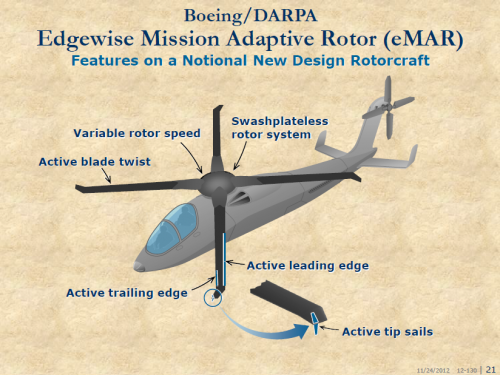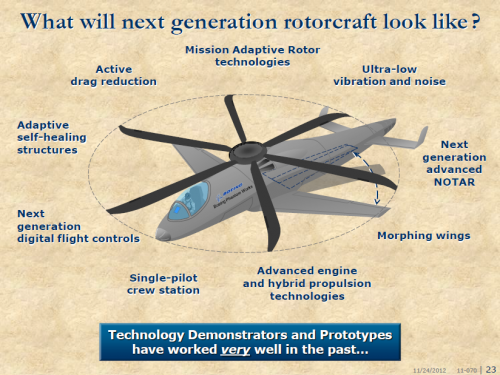- Joined
- 21 April 2009
- Messages
- 13,756
- Reaction score
- 7,696
Darpa Sets Goals For Morphing-Rotor Demo - Jun 9, 2010
By Graham Warwick
Washington
After years of neglect, U.S. rotorcraft technology is to get a boost from a Pentagon research program that aims to fly a shape-changing rotor offering substantially more payload and range with significantly less noise and vibration.
Three teams have been awarded contracts for the initial phase of the Defense Advanced Research Projects Agency’s Mission Adaptive Rotor (MAR). Program managers plan to fly an adaptive rotor by 2018 to ready the technology for the next U.S. military rotorcraft program.
Boeing, Sikorsky and the Bell Boeing tiltrotor team have received 16-month Phase 1 contracts to assess a wide range of adaptive rotor technologies and develop designs for both a clean-sheet “objective” rotor system and a demonstrator rotor that can fly on an existing aircraft.
“Adaptation of all blade attributes are on the table: twist, airfoil, chord, stiffness, rpm., etc.,” says Daniel Newman, Darpa’s MAR program manager. “There are many technologies available. It’s not just any one, it’s about developing multiple adaptive technologies that complement each other.”
Newman says rotor design has remained largely unchanged since the current generation of U.S. military helicopters was introduced in the 1960s and 1970s. While it has invested heavily in advancing fighter technology to today’s fifth-generation F-22 and F-35, “the Defense Department has historically underinvested in rotorcraft, which are still at the equivalent of the F-4 Phantom,” he says.
“The challenge has been developing new rotor technology, because most rotors since then have been modifications, and the few all-new designs have been risk-averse. MAR is an all-new, clean-sheet rotor that will be much less constrained.”
The wings of fixed-wing aircraft are far from fixed, with movable flaps and variable camber that enable lift and drag characteristics to be changed in flight. Wings have been built that can vary in area, chord, span or sweep. In contrast, the aerodynamic and geometric characteristics of a rotor blade are fixed during design, and never change.
The goal of MAR is a rotor that can change its configuration before a mission and in flight, between mission segments and with every revolution. “Adaptation for rotorcraft is a huge opportunity because the blades see a wide range of flight conditions,” says Newman. “They can adapt between mission segments and also around the rotor azimuth.”
The blades on an adaptive rotor could change their length, sweep, chord, camber, tip shape, twist, stiffness, rotational speed or other attributes. Newman says adaptive technology will be “available for any rotor,” including tiltrotors, tail rotors, propellers and “rotating turbomachinery.”
Industry teams are keeping their MAR cards close to their chests, but Sikorsky talks illustratively about iPhone-like “apps” that would allow the pilot to select low noise, high agility, smooth flight or other modes at the touch of an icon on a cockpit display.
http://www.aviationweek.com/aw/generic/story_generic.jsp?channel=defense&id=news/awst/2010/06/07/AW_06_07_2010_p24-231440.xml&headline=Darpa%20Sets%20Goals%20For%20Morphing-Rotor%20Demo
By Graham Warwick
Washington
After years of neglect, U.S. rotorcraft technology is to get a boost from a Pentagon research program that aims to fly a shape-changing rotor offering substantially more payload and range with significantly less noise and vibration.
Three teams have been awarded contracts for the initial phase of the Defense Advanced Research Projects Agency’s Mission Adaptive Rotor (MAR). Program managers plan to fly an adaptive rotor by 2018 to ready the technology for the next U.S. military rotorcraft program.
Boeing, Sikorsky and the Bell Boeing tiltrotor team have received 16-month Phase 1 contracts to assess a wide range of adaptive rotor technologies and develop designs for both a clean-sheet “objective” rotor system and a demonstrator rotor that can fly on an existing aircraft.
“Adaptation of all blade attributes are on the table: twist, airfoil, chord, stiffness, rpm., etc.,” says Daniel Newman, Darpa’s MAR program manager. “There are many technologies available. It’s not just any one, it’s about developing multiple adaptive technologies that complement each other.”
Newman says rotor design has remained largely unchanged since the current generation of U.S. military helicopters was introduced in the 1960s and 1970s. While it has invested heavily in advancing fighter technology to today’s fifth-generation F-22 and F-35, “the Defense Department has historically underinvested in rotorcraft, which are still at the equivalent of the F-4 Phantom,” he says.
“The challenge has been developing new rotor technology, because most rotors since then have been modifications, and the few all-new designs have been risk-averse. MAR is an all-new, clean-sheet rotor that will be much less constrained.”
The wings of fixed-wing aircraft are far from fixed, with movable flaps and variable camber that enable lift and drag characteristics to be changed in flight. Wings have been built that can vary in area, chord, span or sweep. In contrast, the aerodynamic and geometric characteristics of a rotor blade are fixed during design, and never change.
The goal of MAR is a rotor that can change its configuration before a mission and in flight, between mission segments and with every revolution. “Adaptation for rotorcraft is a huge opportunity because the blades see a wide range of flight conditions,” says Newman. “They can adapt between mission segments and also around the rotor azimuth.”
The blades on an adaptive rotor could change their length, sweep, chord, camber, tip shape, twist, stiffness, rotational speed or other attributes. Newman says adaptive technology will be “available for any rotor,” including tiltrotors, tail rotors, propellers and “rotating turbomachinery.”
Industry teams are keeping their MAR cards close to their chests, but Sikorsky talks illustratively about iPhone-like “apps” that would allow the pilot to select low noise, high agility, smooth flight or other modes at the touch of an icon on a cockpit display.
http://www.aviationweek.com/aw/generic/story_generic.jsp?channel=defense&id=news/awst/2010/06/07/AW_06_07_2010_p24-231440.xml&headline=Darpa%20Sets%20Goals%20For%20Morphing-Rotor%20Demo


